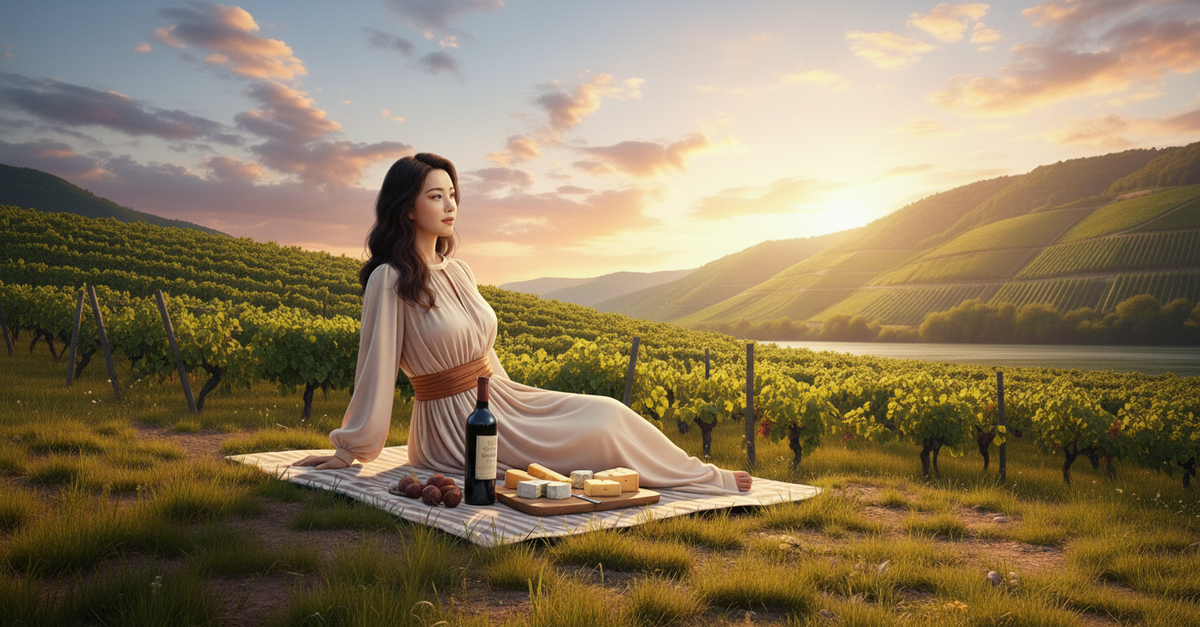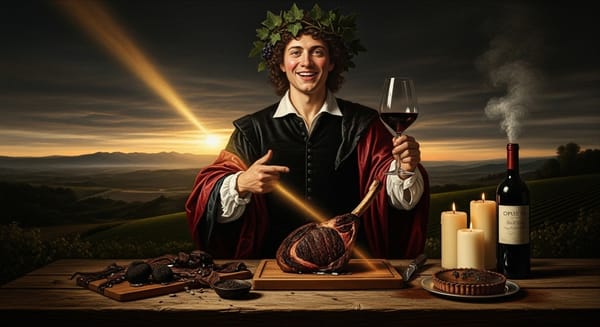The Rhône Valley: The River of Shifting Identities
Journey through the Rhône Valley, a river of contrasting identities. This exploration delves into the North's granite structure and the South's sun-baked Grenache. Learn how the Mistral and unique terroir shape Rhône wine legacy, from Côte-Rôtie to Châteauneuf-du-Pape.

The world insists on defining a place by its edges, but the Rhône is a valley forged by its relentless center. It is not a destination; it is a long, living river of shifting identities, a current of memory flowing from the cold alpine south to the sun-drenched sea. To speak of the Rhône Valley is to speak of elemental contrast: a geology of fury and grace bound by water.
I have watched epochs pass here, felt the earth shudder and settle, only to rise again in granite spires and rolling beds of stone. This is not a landscape that yields easily. It is an emotional terrain, demanding attention not through volume, but through the sheer weight of its presence. Here, the wine does not simply exist; it endures, carrying the temperature of the land and the echo of its passage. The atmosphere is one of profound tension. In the North, it is the chill of rock meeting sky; in the South, the generous, sprawling heat rising from sun-warmed grief-stone. When you hold a Rhône wine, you hold not a simple beverage, but the mineral structure of a thousand miles, contained.
Echoes of the Forgotten Roots
History, in the Rhône, is not a textbook chapter; it is the sediment underfoot. The river has always been a road, carrying the ambition of empires. The Romans established a legacy, understanding that these steep banks and sun-drenched plains were destined for more than simple cultivation, etching their expectations into the very granite.
Later, the valley embraced the authority of the Papacy. The rise of Châteauneuf-du-Pape was a moment of profound declaration: a wine created not for local thirst, but for the sophisticated, political statement of the papal court in Avignon. The sheer complexity of its allowed varieties became its signature of sovereignty. Historically known for the symbolic thirteen grapes woven into its body, modern rules now permit up to eighteen distinct varieties (counting color variants separately), continuing its tradition of composite strength.
Yet, beyond the grand statements, the true lineage lies in the resistant roots of Syrah in the North, and the ancient spread of Grenache in the South. What echoes in the land is the tension between preservation and change. The great houses, standing since the 18th century, represent what has been fiercely guarded; the gnarled, resistant old vines represent the tenacity that endures. The past here is not a story that is told; it is a structure that is inherited, shaping every choice a grower makes today.
Two Souls Bound by a River
To understand the terroir of the Rhône is to understand the geography of emotion. The valley is cleft into two entirely different souls, held together only by the river’s name.
In the Northern Rhône, the geology is sharp, vertical, defined by steep granite slopes that plunge dramatically toward the water. This granite is cold-blooded beauty—it retains heat during the day, giving Syrah its intense structural spine. Here, the elevation and soil feel like fierce, singular personalities: demanding, mineral, and resistant. The climate is continental, forcing the grapes to struggle toward a taut, hard-earned ripeness.
The Southern Rhône is a different state of being—sprawling, sun-baked, and generous. The land here is an expanse of ancient riverbeds. The famed galets roulés are monuments of thermal intensity; these large, smooth stones gather the high valley heat, releasing it back to the vines long into the cool nights. This warmth allows the Grenache to achieve its characteristic depth and sun-charged sweetness. The pervasive, violent breath of the Mistral wind acts as a clarifying force, particularly in the South. This blade-wrapped wind sweeps away disease and forces the vines to anchor themselves deeply. While its cooling influence is felt throughout, its most persistent and vital effects—reducing disease pressure and providing necessary dry air—are concentrated in the Southern sector.
The Graphed Architecture of Emotion
In the Rhône, the dominant grapes embody the elemental forces that shape the valley. Their behavior here defines them utterly, moving far beyond generic tasting notes.
Syrah in the Northern Rhône feels like a contained storm. It does not glide; it grips. Its inherent darkness is mitigated by a high-toned, ferrous minerality drawn from the granite. It tastes of black olive, cracked pepper, and a high-wire tension that speaks of cold nights and steep climbs. It is a wine of structural density, requiring years to fully unwind, revealing its fruit only after the firm frame has softened.
Grenache, the heart of the Southern Rhône, tastes like the heat rising from sun-warmed stone. It is a grape of sprawling, exuberant warmth, but its power is held in check by its savory complexity—notes of dried garrigue, thyme, and red earth. It carries a heavy sweetness, yet is saved from simple ripeness by the sheer mineral force of the stones beneath it. It is generous but never soft.
The white Rhône blends, often overlooked, express a textural gravity. Varietals like Marsanne and Roussanne lend themselves to savory, deep-hued wines. These blends prioritize textural gravity first: the breadth of Marsanne countered by the necessary lift and acidity provided by Roussanne, preventing the deep body from becoming heavy. They carry the perfume of late summer bloom.
Restraint and the Prayer to Balance
Winemaking in the Rhône is a profound philosophical inclination toward the land’s authority. Choices made in the cellar—stem inclusion, barrel age, native yeasts—are not about efficiency; they are belief systems.
The North, particularly in appellations like Cornas, embraces a fierce individualism. The traditional use of stem inclusion is a form of prayer to balance, lending the Syrah a necessary, dry structure that keeps the fruit in check. The winemaking seeks to frame the furious intensity of the granite, embracing a primal, unpolished power. Their discipline is trust in the wild spirit of the vine.
In the South, the stewardship is quieter, focused on managing Grenache’s natural generosity. The use of large, old foudres is not about imparting oak flavor, but about slow, patient breathing. It is a philosophical leaning toward softening the sun’s impact without betraying the warmth of the vintage. Tradition and innovation exist in the duality of balance: ensuring the powerful fruit of the sun is given the structure of the earth.
A Duality of Temperament
The contrast between the Northern Rhône and Southern Rhône is not just one of grape; it is one of temperament and emotional disposition. This is the valley’s essential duality.
The North is a place of narrow, contained, cold-blooded beauty. It speaks of elevation and effort. The river has carved its way through the metamorphic rock, forcing vineyards into singular parcels—Côte-Rôtie, Hermitage, Cornas. The wines reflect this intensity: focused, linear, and aggressively structured. Their personality is one of demanding purity, often expressing itself in dark, ferrous, peppery tension.
The South is sprawling, sun-baked, and generous, a place of convergence and collective identity. The landscape opens up, allowing the grapes to mingle in a chaotic democracy. Châteauneuf-du-Pape is the ultimate expression of this: a wine whose complexity comes from the communion of many different personalities. The mood is one of abundance and untamed, earthy joy. The wines are broad, rich, and textural, expressing a warmth that feels immediate and enveloping. This is the difference between a solitary mountain peak and an expansive, sun-lit plain.
Characters in Clay and Granite
We do not speak of notable appellations / producers as businesses; we speak of them as defining characters whose actions have etched the valley’s soul.
To hold a glass of Jean-Louis Chave Hermitage is to remember someone long gone who still holds influence. It is a wine that is taut, mineral, and possesses a devastating structural integrity—a fierce purity drawn from the granite slopes. Its density is a quiet acknowledgment of the decades it demands.
Conversely, a memory of Château Rayas in the South is one of ethereal lightness, a ghost of Grenache that defies the heat of its region. It is a wine of perfume and unexpected transparency, proving that power can be expressed through absolute clarity.
A sip of Clos des Papes is the deep satisfaction of complexity resolved. It is the archetype of the Southern blend, weaving its disparate grapes into a unified, textural whole that speaks of balance and deep-seated wisdom. These producers are the guardians of the valley’s disparate temperaments.
Legacy, Ritual, and the Unwinding
Rhône wines do not age by simply softening their fruit; they change emotionally. An older Côte-Rôtie is like remembering someone long gone—the raw grief is replaced by fragrant, complex memory. The primal dark fruit is transformed into savory, earthy complexity, a high tone of violet and ferrous quality replacing the immediate storm of youth. The wine’s texture, once tightly bound, unwinds, becoming dense yet yielding, holding its structure without being forced.
This evolution is why service is a ritual, not a set of rules. Decanting is an act of awakening the spirit that has slept. For young, tightly structured reds, a long aeration is often necessary. Yet, for mature bottles, the ritual is one of minimal exposure: decant gently only to separate the sediment, and serve soon after. Extended air can mute the fragile, complex memory achieved over decades. Glassware should be chosen for its capacity to contain and focus the wine's complex, earthy aromatics. It is a devotion to the slow work of time.
Custodianship as Investment
When we speak lightly of investment in the Rhône, it must always be grounded in emotion and place. Rarity here is not just about small production; it is about the uniqueness of the vision—a specific parcel on a perilous slope, a singular choice in the cellar.
Why do people collect these Rhône wine treasures? Because they are investing in legacy, not speculation. They acquire bottles from Hermitage or Châteauneuf-du-Pape not as liquid currency, but as cultural documents—proof of a conversation held between a specific grower and an unrepeatable vintage.
The true philosophy of collecting the Rhône is that beauty, while everywhere, is concentrated in these moments of structural endurance. Investment becomes custodianship—the responsibility to protect a bottle until its character is fully formed, until the moment of its final, complete expression.
The Glassborne River
We return now to the river, the unrelenting center of the Rhône Valley. This is a place of elemental contrast—of fire in the Southern stones, cold structure in the Northern granite, and the constant, abrasive cleansing of the Mistral wind. It is old, breathing, and possessed of a textural truth.
To know the Rhône is to know the enduring tension between the North’s taut intensity and the South’s sun-warmed generosity. It is a lesson in duality—that the purest expression of a grape, be it Syrah or Grenache, is found in the struggle against its confinement.
When the glass is set down, the memory that lingers is not of a single taste, but of distance, time, and earth. It is the lingering impression of stone warmed by grief, of power held perfectly in check, and the enduring pulse of a river that never stops teaching.





